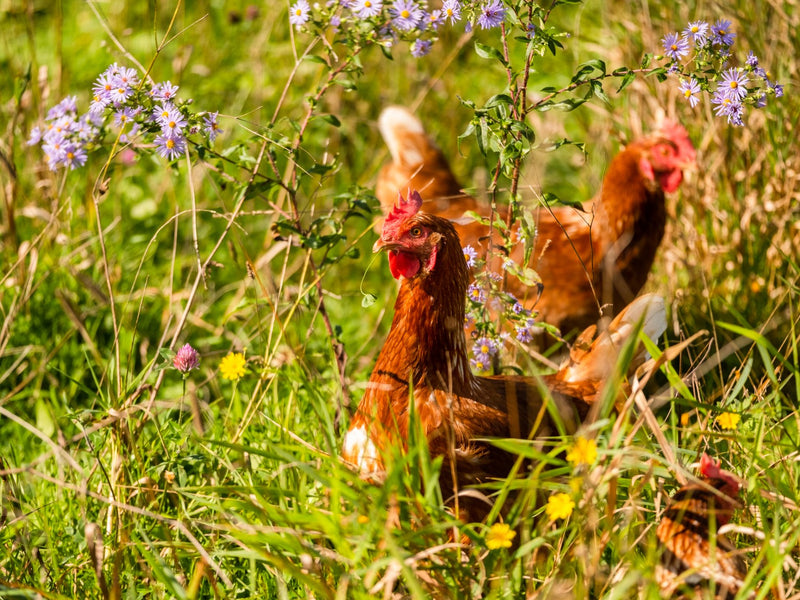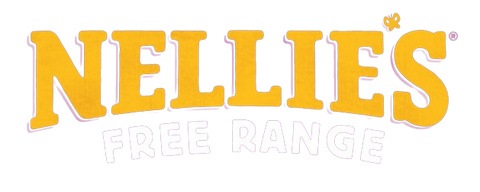
Here at Nellie's Free Range, we get this question a lot: what's the difference between cage-free and free-range?
And it's no surprise. The egg aisle has more unique terms these days than chips have flavor varieties; free-range, cage-free, pasture-raised, GMO-free, organic, farm fresh, all natural, and the list goes on. When it comes to humane standards like cage-free vs free range in particular it can be very hard to know the difference.
Free-range vs. cage-free
There is indeed a significant difference between the Certified Humane Free-Range standard that our family farms produce to and the "cage-free" label that you're seeing more and more in the marketplace. (The quotations around cage-free are there because, as you will see, it's quite misleading). That difference has everything to do with outdoor access. To put it simply, cage-free hens generally have no access to the outdoors, whereas free range hens spend their days in the fresh air and sunshine. Now that you know the basic difference between the two lifestyles, let's take a closer look at what free-range and cage-free really mean.
What does the cage-free label mean?
Most people would reasonably assume cage-free to mean "no cages." But the term is not backed by any regulated USDA or FDA standards (the USDA defines free-range). So what does cage-free actually mean? Egg producers are left to define the term for themselves. And as you might expect, the gigantic factory farms that have always brought you conventional eggs laid by hens imprisoned in tiny floor-to-ceiling battery cages are now either converting these same factories to massive "cage-free" warehouses or building new ones.
And what is going into all of these "cage-free" egg factories? You guessed it: cages. Bigger, more complex cages than before, but cages nonetheless, with no doors to the outside. A typical cage-free "farm" is expected to produce 1.5 million eggs per day. Compare that to a family farm producing just a tiny fraction of that number. As you can imagine, the difference in quality of life for those hens is staggering.
There is no question that placing 10 giant buildings the size of aircraft hangars on a flat piece of earth in the middle of nowhere allows for some serious labor efficiency in terms of handling and processing eggs. But it shouldn't be considered farming, much less humane.
These cage-free egg concerns highlight the misleading nature of the term and the ongoing issues with battery farming.
What does the free-range label mean?
When choosing between cage-free and free-range eggs at the grocery store, it's important to remember there's a big difference between the quality of life offered to the hens who produced them. At Nellie's Free Range, we've gone beyond the misleading term "cage-free." On our family farms, hens are raised with respect and dignity according to Certified Humane's Free-Range standard–one of the strictest animal welfare standards available. Our floor style barns have no cages, period, meaning our hens can stretch and stroll as they please. There are doors every few feet, allowing one and all to roam the pasture when the weather allows. And we wouldn't have it any other way.
Comparing the cost of cage-free vs. free-range eggs: are free-range eggs worth it?
When it comes to cost, free-range eggs are typically a bit more than cage-free eggs. This price difference reflects the higher standards of animal welfare and the additional space and resources required to raise free-range hens.
But are free-range eggs worth it? At Nellie’s, we certainly think so — not only for the ethical treatment of the hens but also for the quality and taste of the eggs themselves.
Are free-range eggs healthier for you?
Another common question is whether free-range eggs are healthier or more nutritious than cage-free eggs. While the nutritional content of eggs can vary based on the hen's diet, free-range eggs often come from hens that have access to a more varied diet, including natural foraging. This can lead to eggs that are richer in certain nutrients, such as omega-3 fatty acids and vitamins.
How to identify true free-range eggs
To ensure you're buying true free-range eggs, look for certifications such as Certified Humane or USDA Organic. These labels indicate that the eggs meet specific standards for animal welfare and outdoor access. At Nellie's Free Range, we pride ourselves on transparency and the humane treatment of our hens, so you can feel confident in the quality of the eggs you purchase.
Please watch our video to see the difference between cage-free and Certified Humane Free-Range standards in action so you can be as informed as possible about the eggs you choose at the grocery store—and know that when you pick up the purple carton, you're supporting kindness and transparency in the egg industry.









